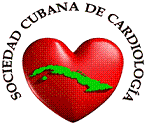Usefulnes of intracavitary recording in the ablation of nodal reentry tachycardia
Keywords:
TACHYCARDIA, ATRIOVENTRICULAR NODAL REENTRY, ARRHYMIA/therapy.Abstract
The results obtained in 3 patient carriers of nodal reentry tachycardia that underwent ablation with radiofrecuency were analized. With the applications of energy on the lower third of Koch's triangle, an exit site of the slow patway conduction, the fast patway was destroyed and a temporary auriculoventricular block was produced. 2 of the patients had a proonged P-R interval and the 3 of them had no retrograde conduction. The recording of the coronary simus during the applications allowed to define enlargements of the ventriculoauricular interval during the coupled rhythm that showed the injury of the retrograde fast pathway and the conduction by the slow pathway. It is concluded that the prolongation of the ventriculoauricular interval appearing with the coupled rhythm dirung the applications of radiofrequency may be a marker that defines the of the fast patway nodal conduction. the intracardiac recording (caronary sinus) is indispensable to make this diagnosis.Downloads
Downloads
Published
How to Cite
Issue
Section
License
Aquellos autores/as que tengan publicaciones con esta revista, aceptan los términos siguientes:- Los autores/as conservarán sus derechos de autor y garantizarán a la revista el derecho de primera publicación de su obra, el cuál estará simultáneamente sujeto a la Attribution-NonCommercial 4.0 Internacional (CC BY-NC 4.0) que permite a terceros compartir la obra siempre que se indique su autor y su primera publicación esta revista. o admite fines comerciales. Permite copiar, distribuir e incluir el artículo en un trabajo colectivo (por ejemplo, una antología), siempre y cuando no exista una finalidad comercial, no se altere ni modifique el artículo y se cite apropiadamente el trabajo original. El Comité Editorial se reserva el derecho de introducir modificaciones de estilo y/o acotar los textos que lo precisen, comprometiéndose a respectar el contenido original.
- Los autores/as podrán adoptar otros acuerdos de licencia no exclusiva de distribución de la versión de la obra publicada (p. ej.: depositarla en un archivo telemático institucional o publicarla en un volumen monográfico) siempre que se indique la publicación inicial en esta revista.
- Se permite y recomienda a los autores/as difundir su obra a través de Internet (p. ej.: en archivos telemáticos institucionales o en su página web) antes y durante el proceso de envío, lo cual puede producir intercambios interesantes y aumentar las citas de la obra publicada. (Véase El efecto del acceso abierto).









